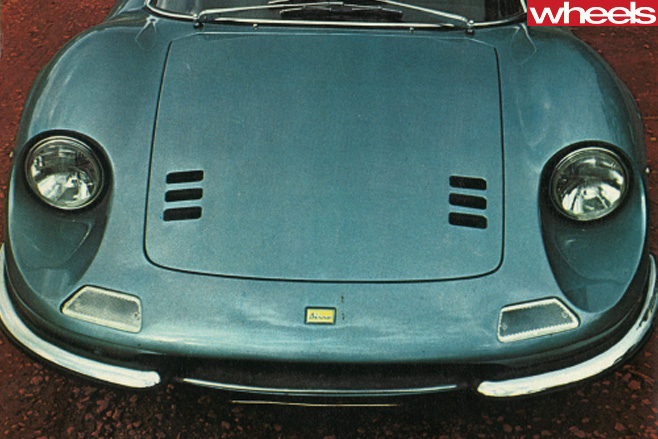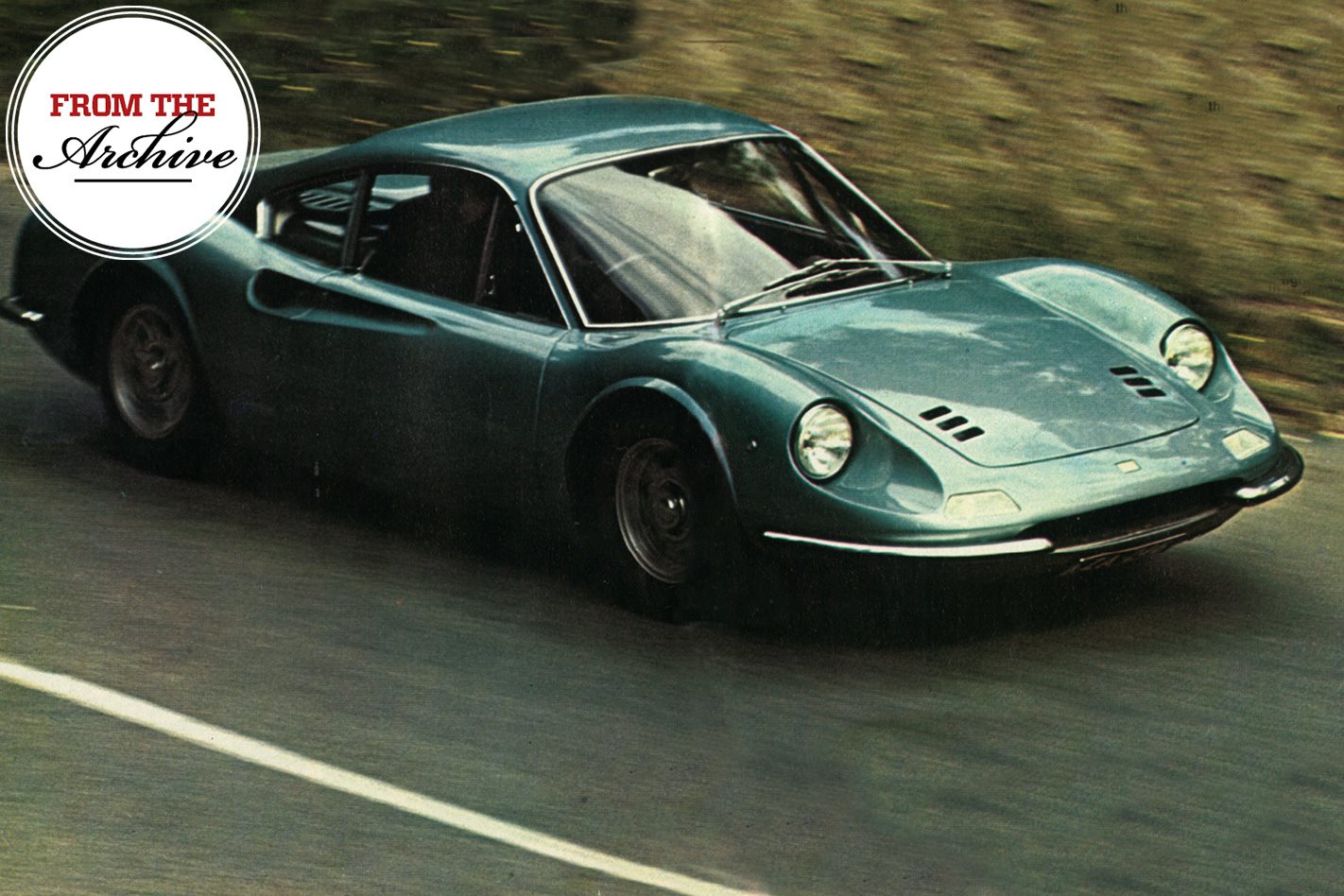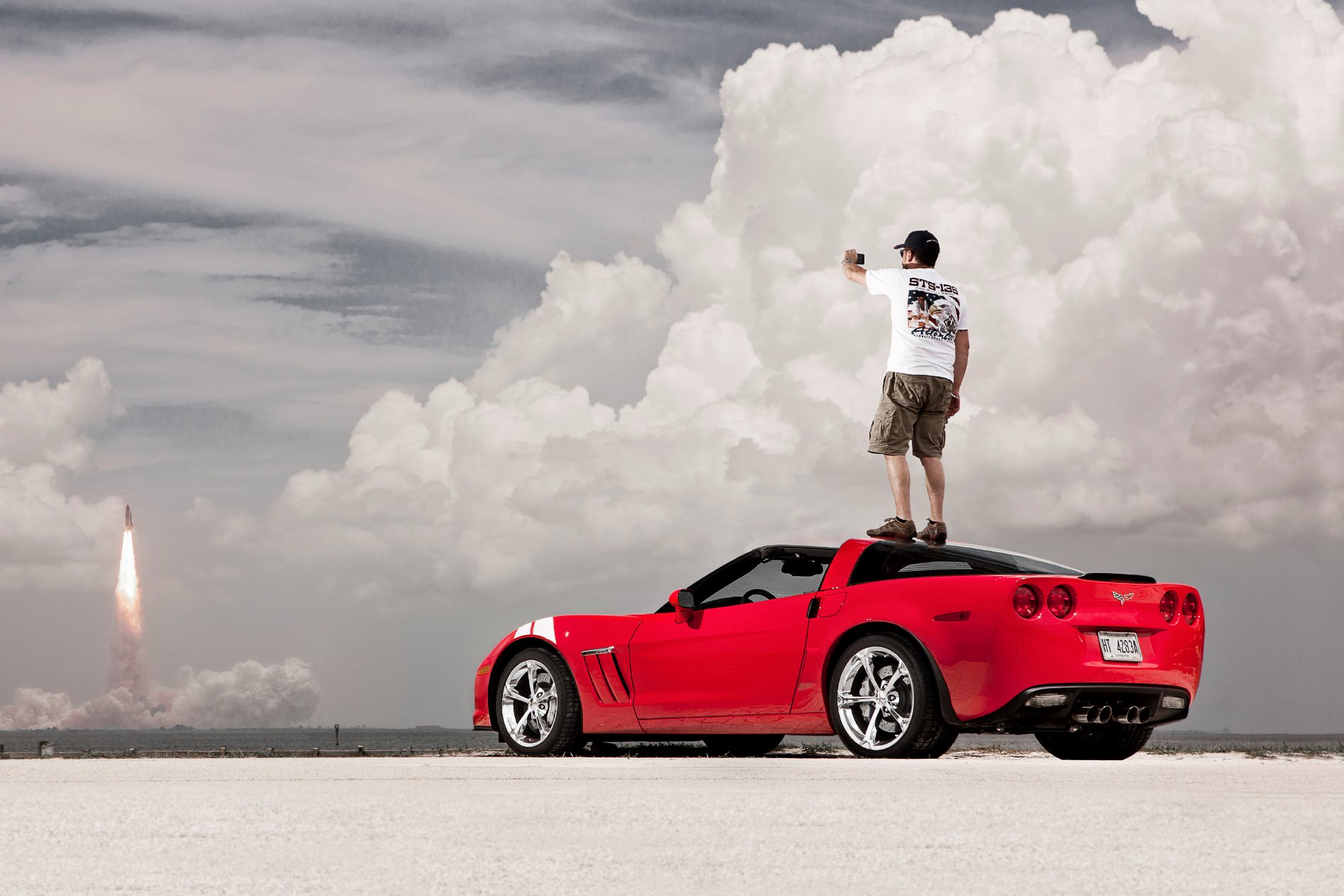Mel Nichols revels in the V6 glory of Ferrari’s first ‘budget’ sports car when it was released in 1973.
First published in the March 1973 issue of Wheels magazine, Australia’s most experienced and most trusted car magazine since 1953.
You leave in the early morning rain, heading for the south coastal in a Ferrari Dino. Along the green, tree-lined avenues of suburban Lindfield, down and across the Sydney Harbor Bridge. Through the city snarl and the southern suburban wrangle and the smog to the coast.
The road that leads out to the southern seashore is twisty. It flies down into, and then up out of, a park of many square miles. It crosses a causeway and snakes up through the trees in a series of bends that are predominantly left hand. Some curl tightly around a cliff face, climbing all the while, but opening out gradually. You can place a car in tight to the cliff going into them fast, screw on full power and sweep through, opening out with the bend itself. As you exit you will grab another gear and maybe another on the uphill run to the next bend – another left-hander – and take it in the same fashion.
A Falcon GT will be running hard in third. A Dino will have gone into fourth, the cam chains wailing and the exhausts howling as its V6 claws up past 6600rpm, heading for the 7800 red line.
But further on up, nearing the top of the hill, this road betrays its consistency. It kicks ‘ hard and nastily to the right in almost a full U-bend. It is easy to forget about it, to come· in much too fast- lured into false security by the smooth flow of the earlier bends.
Too late you see this bend’s spiteful twist. Too late you see the gravel spread like orange ball-bearings across it; the haggard rock bank on the outside edge staring at you coldly.
And too late you remember the only failing of mid-engined cars. That their weight distribution, biased towards the rear, is prone to letting the front wheels suddenly skip across the road if they hit a wet patch, or strewn gravel, in a tight bend …
Many things flash through your mind in that instant before you make a decision and commit yourself to an action that may or may not work, may or may not keep that leering bank and this $16,000 jewel apart…***
… You think about the first time you slipped the key into the dashboard of a Dino. The excitement is easy to remember. You have it every time your hand reaches out to twist the key in a car of breeding, a car that costs a lot of money and you suspect is probably worth every penny of it.
There is the aloof feeling of using something that is of rare high quality, and is duly respected and envied by other drivers less fortunate. There is the feeling of satisfaction and of adventure in the discovery of it that you know lies ahead.
There is anxiety, too, that someone will run into you in a parking lot. But you don’t wait too long before you turn the key.

The 2418 cc oversquare V6, DOHC, sits transversely in the car, between the seats and the rear wheels. The diaphragm clutch is at its left side. From the clutch, three pinion gears drive down to the gearbox which lies beside and parallel to the crankcase; so close that you might think it was in the crankcase, like a Mini’s.
A pair of helical gears take the output from the gearbox to the diff and its drive shafts which, as a result of all this parallel design, are mere inches behind the line-of the crankshaft.
Power from the engine is 195bhp at 7600 rpm, with 166 lb/ft of torque at 5500 rpm. It is a crisp engine, with a reassuringly clean feel to it.
Instantly a very easy, confidence inspiring car to drive, the _Dino is very light in all its controls. It takes quite a while to adjust to this- at first you use too many revs when changing up, not allowing for the swiftness of the gearchange, the rapid take-up of the clutch and the lightness and precision of the throttle. But soon you get it all co-ordinated into the smooth, effortless system that it is and it all becomes second nature. The presence of a naked racing gate is forgotten.
Some people have criticised the Dina’s gearchange, but I find it fine; smooth, and like a precision instrument under your palm, and full of feel.
Though the Dino is red-lined at 7800 rpm, you find yourself changing up around 3000 rpm. The low-down pull of the V6 is so pleasant and smooth you don’t feel that you need any more for quiet motoring.
Even so, once past 3500 rpm you can feel the engine climb up on its cams and really storm ahead. Taking it right out to maximum revs brings not only power you can revel in (not because it’s so strong, but simply so damned nice) but a glorious barking from the exhausts as well.
You become aware of the living sounds behind your head, in a different way this time, as the valves and the cams and the chains do their job at the speeds they really prefer. The noise is all part and parcel of the performance and the car, sports car stuff to the ultimate degree and available only in mid-engined cars.
But the noise has its drawbacks. After a few hundred miles you find its novelty disappears, to become a tiring drone at moderate touring speeds. Above 110 mph the drone goes, and the car is a much more pleasant tourer; there being no wind noise.
The Dino is not a potent car, not really one of your “super cars”. Its standing quarter times are a moderate 15.1 seconds, 0·1 00 mph 17.4 seconds. But the important part, the tremendous part, is that the car’s performance is finely balanced to every other part of it, giving an overall “totality” feel that is probably the most desirable quality in a motor vehicle.
One area where the Dino’s performance does triumph in terms of pure acceleration is above 100 mph. Its time to the ton may be only 17.4 seconds, but the superb body shape and the top-end pull of the engine mean that it maintains it accelerative rate much better than cars that will eat it over the · quarter. For instance, the 2.4 911S records 14.7 second quarters with 17.2 seconds to 100 mph, but its time to 120 mph is 30.8. The Dino gets-there in 28.8 seconds.

You soon learn not to overdrive the Dino. By that I mean using full-power in second or third, which will kick the tail out savagely. Fourth or fifth is smoother, quieter and probably even faster. So after leaving a few bends sideways in full-bore power oversteer you find yourself graduating past the kidstuff to a slow, relaxed style that really is the way you drive a Dino – just letting it flow along the road.
Because of the car’s tremendous handling and roadholding you are, of course, travelling very fast even though your driving actions might seem so slow.
The Dino just comes in, maybe under brakes if it’s a really tight one, maybe down a gear. And then you just accelerate through, the car simply tightening its line as it goes around.
This tightening of the line under power is a strange phenomenon you won’t have experienced before if you haven’t driven other mid-engined cars. It is a characteristic of the type, and a wonderful one at that since it gives the car an ability over and above other types, making cornering not only naturally faster, but safer and more relaxing, too.
You soon get in the system of going in with a light or trailing throttle and then just squeezing the pedal right the way home as you go around the bend.
Backing off bard (and I mean hard) in a bend produces no spin; just a gentle drifting of the tail you learn to trust and love the feeling, using it gently in your driving. Stamping on the brakes will bring little more tail movement; such is the grip on the road. But you do get the feeling that if you did reach the limits, perhaps in the wet on a truly treacherous surface, the Dina might prove to be a very difficult proposition to get back.
Normally though, the only way you’ll really get that tail hanging right out is by booting on full power in first, second or third. Then it comes quick; real quick, and you’ll need a big grab of swift opposite lock then, boy.
Do it, and the ear will answer immediately, and just like a true race car you can leave it as far out as you wish until you feel like winding the lock back off.
With the miles slipping behind you, particularly in winding rain-forested mountain country with lots of descending hairpins you notice that the front is inclined to lose its grip, going into sudden understeer slides if there is water, ice or even round gravel across the apex .
You learn to watch the road very closely, and allow for it, the only time you need ever be at all in doubt in any way about the car’s cornering ability.
The steering has that familiar Ferrari smoothness and light ness and precision that is so pricelessly beautiful. There are 3.1 turns lock-to-lock, but it is still a little low geared. The wheel is also canted away from you at too great an angle, forcing you to tilt the seat to the furthest forward of its three positions to allow an action quick enough for opposite lock work.
Few cars will outbrake the Dino. Tremendously progressive and informative, and with a light pedal, the four vented discs haul the car clown like giant claws.
More miles reveal that the Dina’s seats aren’t very good. The little leather buckets have no squab adjustment – only that three-position tilt for the whole seat, and normal fore and aft travel. The bulk head prevents the seats going back far enough for anyone much over six foot.
Considering the pure sports car that it is, the Dino’s ride is superb. Ferrari has given it long spring travel so that it soaks up bumps instead of thumping over them in the more common fashion. For this reason the Dino will never move off line in bumpy bends.
Driving out and away on country roads, delirious with every moment and movement, you do not notice – nor much care – that the Dino is an impractical car for everyday use. There is nowhere to hang a coat as you drive to an appointment on a hot day; nowhere to put her make-up bag; nowhere to slip your briefcase, or the million other things people get used to slinging into a car. There is only the glovebox and two small door pockets which might very well be taken up with tapes for the stereo deck anyway.
Everything else must go in the boot, which, fortunately, is big and holds plenty of suitcases.

Otherwise, you love this cockpit, for it really is a cockpit. You appreciate the tasteful, almost delicate finish; the leather and the black suede covering the dash board. You love the view through the big, wide windscreen down to the road with only those two big humps where the body flows over the front alloy wheels and their fat Michelin XVRs. If ever a view out of a car had appeal, then this is it.
If the day is hot though you find that you would like – need, really – air-conditioning. The ventilation is typically European. Fine for them maybe, far too weak for us. At the end of your test you pull into a garage to fill the 15.5-gallon tank for the last time. Quick calculations show that you’ve been getting just over 21 mpg, even with that top speed run, and the quick, singing miles through a brace of mountain ranges.
You swing slowly into the owner’s garage, reach out slowly for the key and turn it off, smiling again at the way the engine dies instantly. Even in death it is so businesslike.
The owner comes to your door as you curl out. You smile quietly at each other, for you know what you have shared in the driving of this vehicle.
You thank him and you leave, wondering how long it will be before you drive another one.
***
…there is the slightest of crests as you hit the entrance to this bend that is about to gobble you. Yes, it might just be enough. Back off hard… NOW! Yes it is enough! Enough to accentuate the flick into oversteer to get you more sideways than is normally possible with just throttle back-off.
Your foot aches to stamp back on the throttle, to stop the tail, for it fears a spin. But you won’t – can’t – let it. It must hold off an instant longer, to make sure you are fully sideways to get that Achilles’ heel of a nose lancing tight into the inside of the bend, and before the apex.
You can the gravel waiting, waiting on the road. But it is thinner on this inside edge and if you can keep the nose in there, keep the oversteer on so that when the wheels hit it the whole car and not just the front will slide, you might make it.
Oh no! You’ve stayed off the throttle a fraction too long! The tail is coming around too far. We will spin and go backwards. It will crush the engine.
Quickly, throw the opposite lock on firmly. Push the throttle… and yes, feel that back end bite as the howl behind you gets savage once more. The back holds.
The front wheels hit the gravel, and they skip sure enough, but they’re in opposite lock and the weight has you moving in the right direction.
It’s all over. The car is coming back in to line obediently, as mid-engined cars do when the power is pushed on , and moving cleanly and fast out to the edge of the road, almost at the ideal exit point.
You will not hit the bank. You do not even drop a back wheel off the bitumen as you exit.
You have learnt well about the Dino. Now there is just the road ahead, and soon the coast.
Wheels Road Test Technical Detail
Make: Ferrari Model: Dino Body Type: Coupe Price: $16,000 Color: Blue Milaeage Start: 2036 Milaeage Finish: 2598 Weight: 2380lb (1079kg)
FUEL CONSUMPTION Overall: (7 .5 kpl) 21.2 mpg Cruising: (8.8 kpl) 25 mpg
TEST CONDITIONS Weather: Fine Surface: Castlereagh drag strip Load: Two persons Fuel: Super
SPEEDOMETER ERROR Indicated mph: 30 40 50 60 70 80 90 100 Actual mph: 30 40 49 59 68 77 87 97
PERFORMANCE Piston speed at max bhp: 2989 ft/min Top gear mph per 1000 rpm: (30.5 kph) 19 Engine rpm at max speed: 7800 Lbs (laden) per gross bhp (power-to-weight): (5.5 kg) 12.2
MAXIMUM SPEEDS Fastest run: (241 kph) 150mph Average of all runs: (238 kph) 148 mph Speedometer indication, fastest run: (247 kph) 154 mph
IN GEARS 1st: 41 mph (65 kph) (7800 rpm) 2nd: 59 mph (96 kph) (7800 rpm) 3rd: 87 mph (129 kph) (7800 rpm) 4th: 110 mph (177 kph) (7800 rpm) 5th: 148 mph (238 kph) (7800 rpm)ACCELERATION 0-30 mph: 2.7 sec 0-40 mph: 3.6 sec 0-50 mph: 5.4 sec 0-60 mph: 7.0 sec 0-70 mph: 9.1 sec 0-80 mph: 11.3 sec 0-90 mph: 14.2 sec 0-100 mph: 17.4 secSTANDING QUARTER MILE Fastest Run: 15.1 sec Average all runs: 15.2 sec
BRAKING From 30 mph: (9.1 m) 30ft From 60 mph: (32.8m) 108ft
Specifications
ENGINE Cylinders: Six in V Bore and stroke: 92.5 mm (3.64 in.) x 60 mm (2.36 in .) Cubic capacity: 24.8 cc (48.1 cu in.) Compression ratio: 9 to 1 Valves: DOHC Carburettor: Three 2V downdraught Fuel pump: Two, electric Oil filter: Full flow Power at rpm: 195 (net) bhp at 7600 rpm Torque at rpm: (23.9 kg/m) 1661b/ft at 5500 rpm
TRANSMISSION Type: Manual, five-speed Clutch: Single dry plate Gear lever: location Floor
CHASSIS AND RUNNING GEAR Construction: Tubular steel chassis, steel body Suspension front: Independent, coil springs, wishbones, anti-roll bar Suspension rear: Independent, coil springs, wishbones, anti-roll bar Shock absorbers: Telescopic Steering type: Rack and pinion Turns l to l: 3.0 Turning circle: 10.9 m) 36ft Brakes type: Four-wheel discs, servo assisted, dual circuits Dimensions: (269 mm) 10.6 in. diameter
DIMENSIONS Wheelbase: (2339 mm) 92.1 in. Track front: (1425 mm) 56.1 in. Track rear: (1430 mm) 56.3 in. Length: (4216 mm) 166.2 in. Width: (1701 mm) 67.0 in. Height: (1143 mm) 45.0 in. Fuel tank capacity: (70 litres) 15.5 gallons
TYRES Size: 205/70VR 14 Pressures Front/rear: ( 19/21 kg/cm2) 27/31 psi Make on test car: Michelin XVR
GROUND CLEARANCE Registered: ( 155 mm) 5.5 in.





